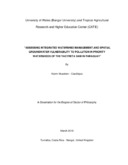Assessing integrated watershed management and spatial groundwater vulnerability to pollution in priority watersheds of the yacyreta dam in paraguay
Description
Ilus. Tab. Bib.
Abstract
This case study research is based in the Watersheds of the Mboi Cae and Quiteria Rivers, and involves a) assessing the current state of knowledge of the watersheds b) an analysis to determine socio-environmental conflicts and to propose solutions and strategies from the perspective of the local watershed council c) the determination of achieved integrated watershed management of the watersheds and d) the assessment of spatial aquifer intrinsic vulnerability to pollution. Socio-environmental conflicts were identified related to deforestation of riparian forests also, pollution of soil and water and soil degradation by malpractices in agriculture health related probleMON, environmental degradation and probleMON derived from solid wastes and their insufficient treatment and deposition. The local watershed council was capable of analysing these prioritized conflicts and proposed strategies according to its legal competence. Assessing IWM showed an advancement of 35 percent of the total obtainable qualification and a set of critical elements were identified to advance towards IWM. Assessing groundwater vulnerability to pollution resulted in intermediate-high levels of vulnerability (DRASTIC: 56 percent of the watersheds with values of 140-159 GOD: 95 percent of the watersheds with values of 0.4 - 0.5), with maximum vulnerability in the lower parts of the watersheds in urban areas and where the flooding of the Yacyreta lake will take place, making it more necessary to consider the threat of urban pollution to the Basalt Aquifer of the Guarani Aquifer System.
Keywords
Publisher
CATIE, Turrialba (Costa Rica)
URI (Permanet link to cite or share this item)
https://repositorio.catie.ac.cr/handle/11554/480http://orton.catie.ac.cr/repdoc/A4675i/A4675i.pdf
Collections
- Publicaciones y documentos [4421]


